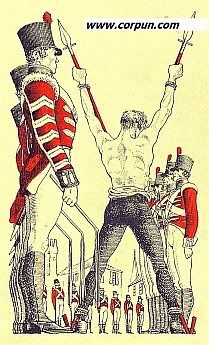Flogging in the British Army, usually applied to a soldier's upper back with a cat-o'-nine-tails, seems to have been fairly common until the middle of the 19th century. Numerous accounts exist of gory ceremonies at which hundreds of lashes were inflicted in front of the offender's comrades, who had to stand to attention and witness the punishment.
These sentences could be handed down by a court-martial for a wide range of military offences. The recipient would generally be "tied to the halberds" in the shape of an X (see illustration, above).
Ordinary flogging by court-martial was abolished by Parliament in 1881. However, this ban did not include punishment in military prisons, where inmates could still be birched on the bare buttocks (see document below).
Boy soldiers were sometimes informally spanked, strapped or caned (see this book review). Schoolboy-type caning was legal at Army Apprentice Schools until the middle 1950s -- see this Oct 1948 news item (with video clip).
Junior soldiers in the "real" army, too, could be sentenced by the Commanding Officer to receive "strokes", a formal caning carried out by the Regimental Sergeant-Major in his office, for which the youth had to change into PE kit and bend over a table (see "Beverley Boy Reminisces" in external links, below). The caning of army boys was officially abolished in 1956, according to this news report.
It is clear that unofficial CP has taken place in the Army from time to time, usually without having come to public notice. An exception was the birching of a Grenadier Guard in 1902, about which questions were asked in the House of Commons. The Commanding Officer who ordered it was reprimanded, but more such cases were reported in 1903.
Another case that was eventually publicly aired occurred during World War 2, in the Burmese jungle in 1943. The artist's impression of it (right) comes from Scott Claver, Under the Lash, Torchstream, London, 1954. A private in the Yorkshire and Lancashire Regiment is being caned (12 strokes) on the buttocks for going to sleep while on sentry duty. This technically illicit punishment was ordered by a Major, who found his men responded much better to speedy corporal punishment than any of the official penalties, which anyway were hardly practicable in the conditions of that place and time. The strokes were delivered by a Regimental Sergeant-Major.
At a court-martial in 1946, it was stated that the punished men had signed a document saying they were willing to accept a caning as an alternative to 28 days' field punishment. "The soldiers concerned took their punishment like sportsmen. It was more of a schoolmaster's caning than the old two hundred lashes," said a witness. Evidence was given that there had in fact been many other such canings, and nobody had ever complained. The court-martial acquitted the Major of any wrongdoing. See this July 1946 news item and this Oct 1946 follow-up.
In 1953 a Lieutenant-Colonel was court-martialled for caning his 18-year-old batman.
 Informal corporal punishment of a soldier by his own comrades is a recurring notion in army history. A 19th-century example was the "company court martial" which involved administering a pants-down strapping to a thief (see document below). For a recent, much more light-hearted case, see this video clip of an army lad being "sentenced" to a painful slippering by his mates for an unspecified "offence", a practice described as "reefing".
Informal corporal punishment of a soldier by his own comrades is a recurring notion in army history. A 19th-century example was the "company court martial" which involved administering a pants-down strapping to a thief (see document below). For a recent, much more light-hearted case, see this video clip of an army lad being "sentenced" to a painful slippering by his mates for an unspecified "offence", a practice described as "reefing".
DOCUMENTS:
Nineteenth-century British army punishments
Details from official records of the use of the strap in informal punishments, and of the birch in military prisons after 1881.
EXTERNAL LINKS: (these will open in a new window) 
Flogging of Drummer Boys.
Flogging of a Drummer-boy in the Guards.
Questions in the House of Commons (March 1903) about illicit caning and birching.
WW2 People's War: War Experiences in Nigeria and Burma
This first-person account by a member of the Essex Regiment in 1944 mentions that a gunner was put on a charge in Burma because his Bren gun had failed, having gone rusty through lack of cleaning. He was "given 20 strokes of the cane (bare bottom)" because "there was no other punishment he could be given in the jungle".
"Beverley Boy" Reminisces
Scroll down to "Members' Memories" for this recollection of a camp in East Yorkshire for boy soldiers in the mid-1950s. Describes reporting to the RSM in PE kit for "strokes" (caning) on the orders of the CO.
Military Miscellany: A History of the Recruiting of the Army, Military Punishments, etc. etc. [PDF]
A book published in London in 1846, now digitised by Google Books and available for free download in its entirety (375 pages). There are numerous references to flogging and other corporal punishments. I have not had time to digest it all yet. I may quote interesting bits from it in due course.
Arborfield Old Boys Association News, Winter 2003/04 [PDF]
1950s reminiscences from the Army Apprentices School at Arborfield (UK). See page 20 for "A letter written to Mrs Moss early in 1955" in which the Commandant invites a parent to give consent to caning. At page 42 under "Echoes from the hills" the former trainee concerned writes that he in fact narrowly escaped a caning there.
 Other external links for military corporal punishment in all countries
Other external links for military corporal punishment in all countries

